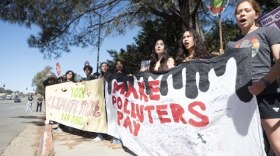The ability of social media to provide information during a disaster was put to a test Friday at San Diego State University.
Professors invited the military, statewide officials and civilians to take part in a mock earthquake that caused major damage from Oceanside to Tijuana. The theory is that individual messages can be captured, analyzed and used to help authorities and the public respond to a catastrophe.
Since the region’s last major disaster -- the 2007 wildfires -- the popularity of social media has exploded. Twitter was just starting and is now approaching 200 million users worldwide. Facebook had one-tenth the users it has today.
Major earthquakes that shook Chile and Haiti showed the power of social media to report on conditions and quickly disseminate the information.
SDSU professor Eric Frost says social media sites can help officials determine the extent of the damage.
“They have tools like Facebook, Twitter, where they can connect to each other and say ‘I’m OK. I’m here. This is what’s taking place. Here’s the fire’,” Frost said. “We can put that together in a massive computing cloud and deliver that up to decision makers.”
Twenty-four nations are participating in the drill, which runs through Saturday. Professors hope their findings will convince authorities to incorporate social media into their disaster response plans.







